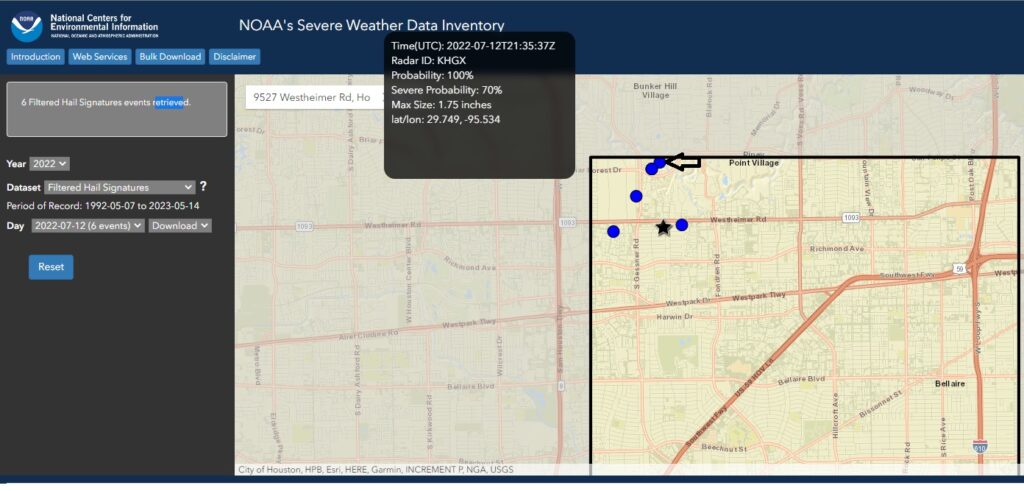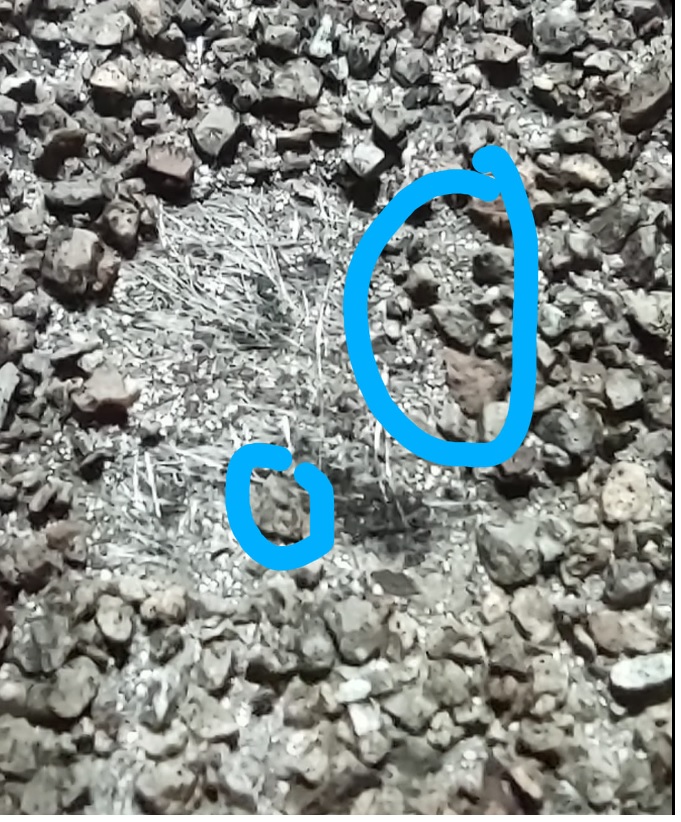We are in property tax protest season. The deadline to file a protest was Monday the 15th, and informal and, if necessary, formal hearings will start soon. The burden is on the taxpayer to establish the condition of the property as of January 1, 2023. Going on the roof to take pictures is a great way to establish hail damage to the roof. However, you still need to establish the damage was present on January 1, 2023. This post shows how to identify hail at a location using National Center for Environmental Information (NCEI) severe weather data inventory and radar base reflectivity imagery.
The first step is to find out if your property was actually impacted by hail. For this example, I’m using a restaurant I go to that had a social media report noting the hail as it happened so there’s no doubt the hail was present. The NCEI severe weather data inventory can be accessed by going to
https://www.ncei.noaa.gov/maps/swdi/
Once you are at the severe weather data inventory page you will need to enter in your address. The database will zoom in to a grid where your property is located. In the left hand frame select 2022 (or 2021) for the year and filtered hail signature for the dataset. If a positive result is found in the grid for the year selected – and not all grids have a positive result in any given year – the day filter will let you access each day that had a positive result for the year. An image like the one below will be the result. (Note: I added the black arrow.)

The pop up box has useful information to show the probability of hail on the ground and severe hail on the ground. As a rule of thumb, it takes severe hail to damage a shingled roof. Modern radar has dual polarization technology. The radar sends out both a horizontal and vertical beam and can actually measure the size of the objects the beam hits. This is how the max size field is populated, and tells you the size of the hail in the cloud. From there the box gives probability of hail on the ground, and also probability of severe hail on the ground. So in this example, we have 1.75 inch diameter hail in the cloud with a 100% probability of hail on the ground, and a 70% probability of severe hail on the ground.
Now that a candidate for damaging hail has been identified before January 1, 2023 we have to track the cell to make sure it passed over the property. To do that, we turn to the NCEI radar. The radar will display the base reflectivity setting, which is the setting that you normally see on the evening news. This identifies the intensity of the objects the beam is hitting. The radar can be accessed at https://www.ncei.noaa.gov/maps/radar/ .
Once you have accessed the radar, click on the search option in the top right portion of the display. It looks like a magnifying glass. A box will appear allowing you to type in your address, and the display will zoom into your address. Next, click on measure, and draw a line over your house. The exact measurement is not important. This is so a pop up box will appear when you pan out identifying where your property is located. While not necessary, it’s a good idea to change the background to the gray canvas selection. Then click on the hand icon to pan (zoom) out so you can see the area surrounding your property.
The radar defaults to current time, so you will need to adjust the date and time in the left hand section of the display. The NCEI severe weather data inventory and radar both operate on Zulu time. The severe weather data inventory pop up box will note the time the cell was identified. Go to the nearest 5 minute interval on the radar, hit the update map button, and it will show the cell close to, if not over, your property.
The next step is to identify the hail bearing cell. To do that, use the Zmax method and Mason Criteria. This method utilizes echo intensity (Zmax) to predict the presence of hail on the ground. This method relies on the physics of the water drops. As the water drops fall they split apart into smaller drops. A hailstone is ice (solid water) and resistant to splitting as it falls. As a result, hailstones show as more intense return echoes than a concentration of water droplets. Any value that is 55 decibels or greater (dark red) is positive for hail on the ground.
The image below is the radar image in our example. Notice that the strongest returns are just to the north of the property, but the property is in the dark red section. The dark red is 55 decibels, and according to the Zmax and Mason Criteria hail algorithm is positive for hail on the ground. The NCEI filtered hail signature gives the verification that this is not a false positive, and the probability of severe hail on the ground. In this instance people at the restaurant at the time posted on social media about the hail so we have an additional layer of information establishing that hail was present.

The final step is to get pictures of the hail damage on your roof. For tax protest purposes damage is damage. However, the goal is to establish that the damage occurred before January 1, 2023 so we have to look for distinct hail spatter marks rather than something like a heat blister. Hail spatter marks have two signs to indicate the damage is from hail rather than a heat blister. The picture below is an extreme close up image of a hail spatter mark. We know this because some of the individual asphalt granules are impressed into the damage.

A second sign that damage is from hail is in the border of the spatter mark. When hail falls it has a vertical vector because of gravity. However, it also has a horizontal vector because of the wind it falls through on the way down. The combination of vertical and horizontal vectors to the hailstone’s direction means the hailstone hits the roof and is pushed slightly into the shingle before it bounces off the roof. This causes the spatter mark to have a shallow and a sharp border, as seen in the picture below. (Also, note a couple of granules are pushed into the spatter mark.)

Hopefully this helps everyone have support for a CDU change to their appraisal and can help lower assessed value. Also, hopefully this will help you to notice hail damage before it gets through the roof and into your attic and causes more damage.
